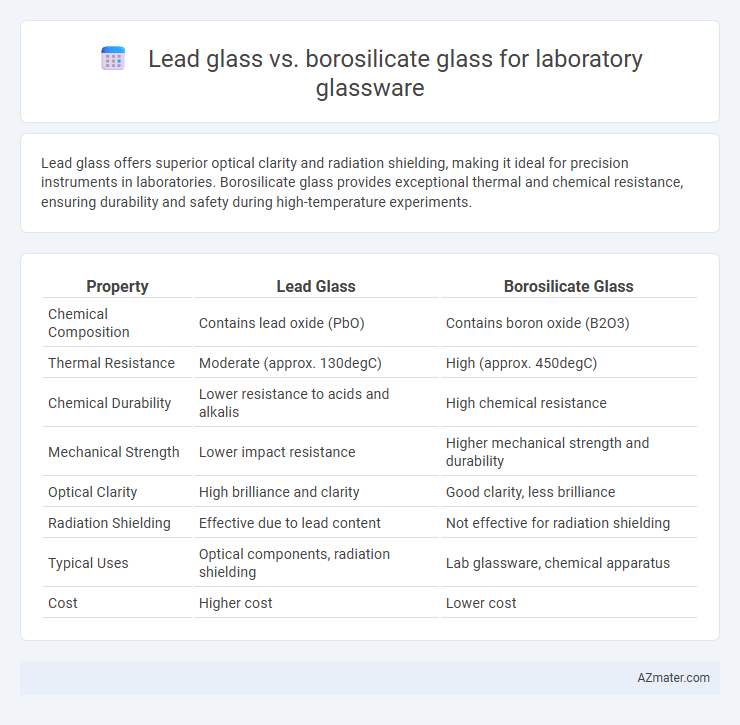Lead glass offers superior optical clarity and radiation shielding, making it ideal for precision instruments in laboratories. Borosilicate glass provides exceptional thermal and chemical resistance, ensuring durability and safety during high-temperature experiments.
Table of Comparison
| Property | Lead Glass | Borosilicate Glass |
|---|---|---|
| Chemical Composition | Contains lead oxide (PbO) | Contains boron oxide (B2O3) |
| Thermal Resistance | Moderate (approx. 130degC) | High (approx. 450degC) |
| Chemical Durability | Lower resistance to acids and alkalis | High chemical resistance |
| Mechanical Strength | Lower impact resistance | Higher mechanical strength and durability |
| Optical Clarity | High brilliance and clarity | Good clarity, less brilliance |
| Radiation Shielding | Effective due to lead content | Not effective for radiation shielding |
| Typical Uses | Optical components, radiation shielding | Lab glassware, chemical apparatus |
| Cost | Higher cost | Lower cost |
Introduction to Laboratory Glassware Materials
Laboratory glassware commonly involves lead glass and borosilicate glass, each offering distinct advantages for scientific applications. Lead glass features high density and excellent optical clarity, ideal for precise measurement and volumetric analysis, while borosilicate glass provides superior thermal shock resistance and chemical durability, making it suitable for heating and handling aggressive reagents. Selecting the appropriate glass material depends largely on the specific laboratory tasks, temperature ranges, and chemical exposure involved in experimentation.
Chemical Composition: Lead Glass vs Borosilicate Glass
Lead glass contains a significant percentage of lead oxide (PbO), typically ranging from 20% to 60%, which increases its density and refractive index, making it highly resistant to corrosion by alkalis and acids. Borosilicate glass primarily comprises silica (SiO2) and boron trioxide (B2O3), with silica content around 70-80% and boron oxide around 10-15%, providing excellent thermal resistance and chemical durability. The presence of lead in lead glass enhances optical properties but reduces thermal shock resistance compared to the more chemically stable and heat-resistant borosilicate glass.
Thermal Resistance and Stability
Borosilicate glass offers superior thermal resistance and stability compared to lead glass, with a low coefficient of thermal expansion (around 3.3 x 10-6 /degC) that minimizes stress and reduces the risk of cracking under rapid temperature changes. Lead glass, while providing excellent optical clarity and higher density, generally has a higher thermal expansion coefficient, making it less suitable for high-temperature laboratory applications. Laboratories prioritize borosilicate glass for its durability and resistance to thermal shock in processes involving heating and cooling cycles.
Mechanical Strength and Durability
Borosilicate glass offers superior mechanical strength and durability compared to lead glass, making it the preferred choice for laboratory glassware subjected to thermal and mechanical stresses. Its low coefficient of thermal expansion reduces the risk of cracking under rapid temperature changes, while lead glass, though more refractive, is softer and more prone to mechanical damage. The enhanced chemical resistance and toughness of borosilicate glass ensure longer lifespan and safety during rigorous experimental procedures.
Chemical Resistance and Compatibility
Lead glass offers high density and excellent optical clarity but has lower chemical resistance, especially to strong bases and hydrofluoric acid, limiting its compatibility with aggressive laboratory chemicals. Borosilicate glass is highly resistant to chemical corrosion, including acids, alkalis, and organic solvents, making it the preferred choice for labware exposed to diverse chemical environments. Its superior thermal and chemical stability ensures broader compatibility with rigorous laboratory procedures and repeated sterilizations.
Optical Properties and Clarity
Lead glass exhibits superior brilliance and high refractive index, resulting in exceptional optical clarity and enhanced light dispersion, ideal for precise visual observations in laboratory glassware. Borosilicate glass offers excellent thermal and chemical resistance with good optical clarity, though its refractive index and light transmission are lower compared to lead glass. The choice between lead glass and borosilicate glass depends on the need for optical precision versus durability and resistance to thermal shock in lab applications.
Safety Concerns: Lead Toxicity and Handling
Lead glass, containing up to 30% lead oxide, poses significant safety concerns in laboratory glassware due to potential lead leaching and toxicity upon breakage or prolonged exposure to acidic substances. Borosilicate glass, composed mainly of silica and boron trioxide, offers superior chemical resistance and non-toxicity, making it a safer choice for handling volatile chemicals and high-temperature experiments. Proper handling protocols and frequent inspection are critical when using lead glass to minimize exposure risks, whereas borosilicate glass reduces health hazards and environmental contamination in laboratory settings.
Cost and Availability
Lead glass typically costs more due to its higher lead content and specialized manufacturing processes, making it less widely available compared to borosilicate glass. Borosilicate glass is more affordable and commonly found in laboratory settings because of its excellent thermal resistance and chemical durability. The widespread availability of borosilicate glass makes it the preferred choice for most standard laboratory glassware applications.
Common Laboratory Applications
Lead glass offers superior clarity and high refractive index, making it ideal for optical instruments and precision measurement devices in laboratories, but its chemical resistance is lower compared to borosilicate glass. Borosilicate glass is the preferred choice for general laboratory glassware such as beakers, flasks, and test tubes due to its excellent thermal resistance, durability, and chemical inertness, allowing it to withstand rapid temperature changes and exposure to corrosive substances. Common applications of borosilicate glass include heating and mixing chemicals, while lead glass is often reserved for specialized optical experiments and radiation shielding in analytical equipment.
Conclusion: Choosing the Right Glass for Your Needs
Lead glass offers superior clarity and radiation shielding, making it ideal for applications requiring enhanced visibility and protection from X-rays. Borosilicate glass excels in thermal resistance and chemical durability, suitable for high-temperature reactions and handling aggressive chemicals. Selecting the right glass depends on specific laboratory needs, with borosilicate preferred for general-purpose and high-heat use, while lead glass is chosen for precision optical work and radiation safety.

Infographic: Lead glass vs Borosilicate glass for Laboratory glassware
 azmater.com
azmater.com